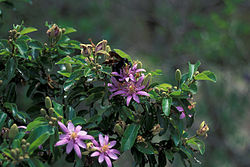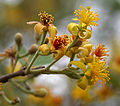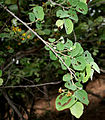Grewia: Difference between revisions
Jmontilla4 (talk | contribs) No edit summary |
No edit summary |
||
| Line 1: | Line 1: | ||
{{SPlantbox | {{SPlantbox | ||
|familia=Malvaceae | |||
|genus=Grewia | |genus=Grewia | ||
|habit=shrub | |habit=shrub | ||
|habit_ref=Flora - A Gardener's Encyclopedia ISBN 0881925381 | |habit_ref=Flora - A Gardener's Encyclopedia ISBN 0881925381 | ||
|lifespan=perennial | |||
|Temp Metric=°F | |Temp Metric=°F | ||
|jumpin=If this plant info box on watering; zones; height; etc. is mostly empty you can click on the edit tab and fill in the blanks! | |jumpin=If this plant info box on watering; zones; height; etc. is mostly empty you can click on the edit tab and fill in the blanks! | ||
|image= | |image=Starr 980529-4195 Grewia occidentalis.jpg | ||
|image_width=240 | |image_width=240 | ||
|image_caption=Crossberry (''[[Grewia occidentalis]]'') | |||
}} | }} | ||
The large [[flowering plant]] [[genus]] '''''Grewia''''' is today placed by most authors in the mallow [[family (biology)|family]] [[Malvaceae]], in the expanded sense as proposed by in the [[Angiosperm Phylogeny Group|APG]]. Formerly, it was placed in either the linden family ([[Tiliaceae]]) or the [[Sparrmanniaceae]]. However, these were both not [[monophyletic]] with respect to other [[Malvales]] - as already indicated by the uncertainties surrounding placement of ''Grewia'' and similar genera - and have thus been merged into the Malvaceae. Together with the bulk of the former Sparrmanniaceae, ''Grewia'' is in the [[subfamily]] [[Grewioideae]] and therein the [[tribe (biology)|tribe]] [[Grewieae]], of which it is the [[type genus]].<ref>Heywood ''et al.'' (2007)</ref> | |||
| | Several species, namely Phalsa, are known for their edible fruit, which are of local commercial importance. The [[astringent]] and refreshing ''Grewia'' [[drupe]]s are particularly popular in summertime. [[Folk medicine]] makes use of some species, which are reputed to cure upset stomachs and some skin and intestinal infections, and seem to have mild [[antibiotic]] properties. ''[[Grewia mollis|G. mollis]]'' is reputed to contain [[beta-Carboline|β-carboline]] [[alkaloid]]s<ref>Brown (2001)</ref>, though whether such compounds occur in other species too and whether they are produced in quantities to render the plants [[psychoactive]] has not been thoroughly studied. | ||
| | |||
| | |||
| | |||
| | |||
{{Inc| | {{Inc| | ||
Grewia (Nehemiah Grew, of Coventry, 1628-1682, author of a work on anatomy of plants). Tiliaceae. Two or three woody plants slightly cultivated in southern Florida. | Grewia (Nehemiah Grew, of Coventry, 1628-1682, author of a work on anatomy of plants). Tiliaceae. Two or three woody plants slightly cultivated in southern Florida. | ||
A genus of about 70 species of trees and shrubs in the warmer parts of the world, often having stellate pubescence: lvs. entire or serrate, 1-9-nerved: fls. yellow or rarely purple, in axillary, few-fld. cymes or terminal panicles; petals 5, with pits or glands inside at the base; stamens indefinite; ovary 2-4-celled: drupe 1-4-stoned. G. caffra, Meissn., from Natal, was intro. by Beasoner Bros, in 1891. A bushy plant with young shoots and lvs. glabrous and with purple star-shaped fls. borne during most of the year. G. denticulata, Wall., from India, was never described. Under this name Reasoner cult, a plant "resembling a mulberry in growth, which bears enormous quantities of acid drupes, about the size of cranberries; used for Eickling." G. oppositifolia, Roxbg., is a rough, much- ranched tree, with distichous, crenate-serrate lvs. and fls. in umbellate cymes, borne opposite the lvs.: fls. yellowish, the oblong petals half the length of the sepals. | A genus of about 70 species of trees and shrubs in the warmer parts of the world, often having stellate pubescence: lvs. entire or serrate, 1-9-nerved: fls. yellow or rarely purple, in axillary, few-fld. cymes or terminal panicles; petals 5, with pits or glands inside at the base; stamens indefinite; ovary 2-4-celled: drupe 1-4-stoned. G. caffra, Meissn., from Natal, was intro. by Beasoner Bros, in 1891. A bushy plant with young shoots and lvs. glabrous and with purple star-shaped fls. borne during most of the year. G. denticulata, Wall., from India, was never described. Under this name Reasoner cult, a plant "resembling a mulberry in growth, which bears enormous quantities of acid drupes, about the size of cranberries; used for Eickling." G. oppositifolia, Roxbg., is a rough, much- ranched tree, with distichous, crenate-serrate lvs. and fls. in umbellate cymes, borne opposite the lvs.: fls. yellowish, the oblong petals half the length of the sepals. | ||
}} | }} | ||
| Line 58: | Line 31: | ||
==Species== | ==Species== | ||
< | Selected species{{wp}}: | ||
* ''[[Grewia abutifolia]]'' (= ''G. sclerophylla'' <small>Roxb. ex G. Don</small>, ''Sterculia tiliacea'' <small>Leveille</small>) | |||
* ''[[Grewia aldabrensis]]'' | |||
* ''[[Grewia asiatica]]'' – [[Phalsa]], Falsa | |||
* ''[[Grewia avellana]]'' <small>Hiern.</small> (= ''G. calycina'' <small>N.E.Br.</small>, ''G. hydrophila'' <small>K.Schum.</small>, ''G. perennans'' <small>K.Schum.</small>) | |||
* ''[[Grewia bicolor]]'' <small>Juss.</small> (= ''G. disticha'' <small>Dinter & Burret</small>, ''G. grisea'', ''G. kwebensis'' <small>N.E.Br.</small>, ''G. miniata'' <small>Mast. ex Hiern.</small>, ''G. mossambicensis'') | |||
* ''[[Grewia biloba]]'' <small>G.Don</small> – [[Bilobed Grewia]] (= ''G. biloba'' var. ''glabrescens'' <small>(Benth.) Rehder</small>, ''G. glabrescens'' <small>Benth.</small>, ''G. parviflora'' var. ''glabrescens'' <small>(Benth.) Rehder & E.H.Wilson</small>) | |||
** ''Grewia biloba'' var. ''microphylla'' <small>(Maxim) Hand.-Mazz.</small> (= ''G. parviflora'' var. ''microphylla'' <small>Maxim.</small>) | |||
** ''Grewia biloba'' var. ''parviflora'' <small>(Bunge) Hand.-Mazz.</small> (= ''G. chanetii'' <small>H.Lév.</small>, ''G. parviflora'' <small>Bunge</small>, ''G. parviflora'' var. ''velutina'' <small>Pampanini</small>) | |||
* ''[[Grewia bilocularis]]'' | |||
* ''[[Grewia caffra]]'' <small>Meisn.</small> (= ''G. fruticetorum'' <small>J.R.Drummond ex Baker f.</small>) | |||
* ''[[Grewia calymmatosepala]]'' <small>K.Schum.</small> | |||
* ''[[Grewia celtidifolia]]'' Juss. (= ''G. asiatica'' var. ''celtidifolia'' <small>(Jussieu) L.F.Gagnepain</small>, ''G. simaoensis'' <small>Y.Y.Qian</small>, ''G. yunnanensis'' <small>H.T.Chang</small>) | |||
* ''[[Grewia ciclea]]''{{Verify source|date=June 2008}}<!-- name is untraceable, probably spelling error --> – ''andilambarika'' ([[Malagasy (language)|Malagasy]]) | |||
* ''[[Grewia crenata]]'' <small>(J.R.Forst.) Schinz & Guillaumin</small> (= ''G. malococca, G. persicaefolia, G. prunifolia, Mallococca crenata'') – ''au‘ere'' ([[Cook Islands]]), ''fau ui'' ([[Samoa]]), ''fo ui'' ([[Tonga]])<!-- Micronesica40:169. --> | |||
* ''[[Grewia damine]]'' <small>Gaertn.</small> (= ''G. salviifolia'' <small>B.Heyne ex Roth</small>)<!-- note "G. salviifolia L.f." below --> | |||
* ''[[Grewia eriocarpa]]'' <small>Juss.</small> (= ''G. boehmeriifolia'' <small>Kanehira & Sasaki</small>, ''G. elastica'' <small>Royle</small>, ''G. lantsangensis'' <small>Hu</small>) | |||
* ''[[Grewia flava]]'' <small>DC.</small> (= ''G. cana'' <small>Sond.</small>, ''G. hermannioides'' <small>Harv.</small>) | |||
* ''[[Grewia flavescens]]'' <small>Juss.</small> (= ''G. flavescens'' var. ''longipedunculata'' <small>Burret</small>) | |||
* ''[[Grewia glabra]]'' <small>Blume</small> – sometimes included in ''G. multiflora'' | |||
* ''[[Grewia goetzeana]]'' | |||
* ''[[Grewia hexamita]]'' <small>Burret</small> (= ''G. messinica'' <small>Burtt Davy & Greenway</small>, ''G. schweickerdtii'' <small>Burret</small>) | |||
* ''[[Grewia hirsuta]]'' <small>Vahl.</small> | |||
* ''[[Grewia hornbyi]]'' <small>Wild</small> | |||
* ''[[Grewia inaequilatera]]'' <small>Garcke</small> | |||
* ''[[Grewia lasiocarpa]]'' <small>E.Mey. ex Harv.</small> | |||
* ''[[Grewia limae]]'' | |||
* ''[[Grewia microthyrsa]]'' <small>K.Schum. ex Burret</small> | |||
* ''[[Grewia milleri]]'' | |||
* ''[[Grewia mollis]]'' <small>Juss.</small> | |||
* ''[[Grewia monticola]]'' <small>Sond.</small> (= ''G. cordata'' <small>N.E.Br.</small>, ''G. discolor'', <small>N.E.Br.</small>) | |||
* ''[[Grewia multiflora]]'' <small>Juss.</small> (= ''G. didyma'' <small>Roxb. ex G.Don</small>, ''G. disperma'' <small>Rottler</small>, ''G. guazumifolia'' <small>Juss.</small>, ''G. jinghongensis'' <small>Y.Y.Qian</small>, ''G. oblongifolia'' <small>Blume</small>, ''G. serrulata'' <small>DC.</small>) | |||
* ''[[Grewia occidentalis]]'' <small>L.</small> – Crossberry | |||
* ''[[Grewia olukondae]]'' <small>Schinz.</small> (= ''G. flavescens'' var. ''olukondae'' <small>(Schinz) Wild</small>) | |||
* ''[[Grewia optiva]]'' <small>J.R.Drumm. ex Burret</small> (= ''G. oppositifolia'' <small>Buch.-Ham. ex D.Don</small>) | |||
* ''[[Grewia oxyphylla]]'' <small>Burret</small> (= ''G. orientalis'' <small>L.</small>) | |||
* ''[[Grewia pachycalyx]]'' <small>K.Schum.</small> | |||
* ''[[Grewia retinervis]]'' <small>Burret</small> (= ''G. deserticola'' <small>Ulbr.</small>) | |||
* ''[[Grewia retusifolia]]'' <small>Kurz</small> | |||
* ''[[Grewia salicifolia]]'' | |||
* ''[[Grewia schinzii]]'' <small>K.Schum.</small> (= ''G. velutinissima'' <small>Dunkley</small>) | |||
* ''[[Grewia similis]]'' <small>K.Schum.</small> | |||
* ''[[Grewia stolzii]]'' <small>Ulbr.</small> | |||
* ''[[Grewia sulcata]]'' <small>Mast.</small> | |||
* ''[[Grewia tenax]]'' <small>(Forssk.)</small> (= ''Chadara tenax'' <small>Forssk.</small>, ''G. populifolia'' <small>Vahl</small>) | |||
* ''[[Grewia tiliifolia]]'' <small>Vahl</small> (= ''G. rotunda'' <small>C.Y.Wu</small>, ''G. tiliaefolia'' <small>(''[[lapsus]]'')</small>, ''Tilia rotunda'' <small>C.Y.Wu & H.T.Chang</small>) | |||
* ''[[Grewia transzambesica]]'' | |||
* ''[[Grewia turbinata]]'' | |||
* ''[[Grewia villosa]]'' | |||
==Gallery== | ==Gallery== | ||
<gallery perrow=5> | |||
File:Grewia damine in Hyderabad W2 IMG_9430.jpg|''[[Grewia damine]]'' flowers | |||
Image:Grewia flavescens (G pilosa)- Khatkhati in Hyderabad, AP W IMG 9130.jpg|''[[Grewia flavescens]]'' flowers | |||
File:Grewia tiliaefolia flowers & leaves in Hyderabad W2 IMG_9422.jpg|''[[Grewia tiliaefolia]]'' flowers | |||
Image: | Image:Grewia flavescens (G pilosa)- Khatkhati in Hyderabad, AP W IMG 9133.jpg|''[[Grewia flavescens]]'' | ||
Image: | Image:Grewia flavescens (G pilosa)- Khatkhati in Hyderabad, AP W IMG 9132.jpg|''[[Grewia flavescens]]'' | ||
File:Grewia tiliaefolia flruits & leaves in Hyderabad W IMG_9426.jpg|''[[Grewia tiliifolia]]'' | |||
File:Grewia damine in Hyderabad W IMG_9390.jpg|''[[Grewia damine]]'' in [[Hyderabad, India]]. | |||
Image:Grewia crenata.jpg|''[[Grewia crenata]]'' foliage | |||
Image:Grewia tenax Bild0687.jpg|''[[Grewia tenax]]'' flower | |||
</gallery> | </gallery> | ||
| Line 79: | Line 104: | ||
{{stub}} | {{stub}} | ||
__NOTOC__ | |||
Latest revision as of 19:49, 9 August 2010
| Grewia subsp. var. | ||||||||||||||||||||||||||||||||||||||||||||||||||||||||
|---|---|---|---|---|---|---|---|---|---|---|---|---|---|---|---|---|---|---|---|---|---|---|---|---|---|---|---|---|---|---|---|---|---|---|---|---|---|---|---|---|---|---|---|---|---|---|---|---|---|---|---|---|---|---|---|---|

|
|
| ||||||||||||||||||||||||||||||||||||||||||||||||||||||
| ||||||||||||||||||||||||||||||||||||||||||||||||||||||||
The large flowering plant genus Grewia is today placed by most authors in the mallow family Malvaceae, in the expanded sense as proposed by in the APG. Formerly, it was placed in either the linden family (Tiliaceae) or the Sparrmanniaceae. However, these were both not monophyletic with respect to other Malvales - as already indicated by the uncertainties surrounding placement of Grewia and similar genera - and have thus been merged into the Malvaceae. Together with the bulk of the former Sparrmanniaceae, Grewia is in the subfamily Grewioideae and therein the tribe Grewieae, of which it is the type genus.[1]
Several species, namely Phalsa, are known for their edible fruit, which are of local commercial importance. The astringent and refreshing Grewia drupes are particularly popular in summertime. Folk medicine makes use of some species, which are reputed to cure upset stomachs and some skin and intestinal infections, and seem to have mild antibiotic properties. G. mollis is reputed to contain β-carboline alkaloids[2], though whether such compounds occur in other species too and whether they are produced in quantities to render the plants psychoactive has not been thoroughly studied.
| Standard Cyclopedia of Horticulture |
|---|
|
Grewia (Nehemiah Grew, of Coventry, 1628-1682, author of a work on anatomy of plants). Tiliaceae. Two or three woody plants slightly cultivated in southern Florida. A genus of about 70 species of trees and shrubs in the warmer parts of the world, often having stellate pubescence: lvs. entire or serrate, 1-9-nerved: fls. yellow or rarely purple, in axillary, few-fld. cymes or terminal panicles; petals 5, with pits or glands inside at the base; stamens indefinite; ovary 2-4-celled: drupe 1-4-stoned. G. caffra, Meissn., from Natal, was intro. by Beasoner Bros, in 1891. A bushy plant with young shoots and lvs. glabrous and with purple star-shaped fls. borne during most of the year. G. denticulata, Wall., from India, was never described. Under this name Reasoner cult, a plant "resembling a mulberry in growth, which bears enormous quantities of acid drupes, about the size of cranberries; used for Eickling." G. oppositifolia, Roxbg., is a rough, much- ranched tree, with distichous, crenate-serrate lvs. and fls. in umbellate cymes, borne opposite the lvs.: fls. yellowish, the oblong petals half the length of the sepals.
|
Cultivation
- Do you have cultivation info on this plant? Edit this section!
Propagation
- Do you have propagation info on this plant? Edit this section!
Pests and diseases
- Do you have pest and disease info on this plant? Edit this section!
Species
Selected specieswp:
- Grewia abutifolia (= G. sclerophylla Roxb. ex G. Don, Sterculia tiliacea Leveille)
- Grewia aldabrensis
- Grewia asiatica – Phalsa, Falsa
- Grewia avellana Hiern. (= G. calycina N.E.Br., G. hydrophila K.Schum., G. perennans K.Schum.)
- Grewia bicolor Juss. (= G. disticha Dinter & Burret, G. grisea, G. kwebensis N.E.Br., G. miniata Mast. ex Hiern., G. mossambicensis)
- Grewia biloba G.Don – Bilobed Grewia (= G. biloba var. glabrescens (Benth.) Rehder, G. glabrescens Benth., G. parviflora var. glabrescens (Benth.) Rehder & E.H.Wilson)
- Grewia biloba var. microphylla (Maxim) Hand.-Mazz. (= G. parviflora var. microphylla Maxim.)
- Grewia biloba var. parviflora (Bunge) Hand.-Mazz. (= G. chanetii H.Lév., G. parviflora Bunge, G. parviflora var. velutina Pampanini)
- Grewia bilocularis
- Grewia caffra Meisn. (= G. fruticetorum J.R.Drummond ex Baker f.)
- Grewia calymmatosepala K.Schum.
- Grewia celtidifolia Juss. (= G. asiatica var. celtidifolia (Jussieu) L.F.Gagnepain, G. simaoensis Y.Y.Qian, G. yunnanensis H.T.Chang)
- Grewia cicleaTemplate:Verify source – andilambarika (Malagasy)
- Grewia crenata (J.R.Forst.) Schinz & Guillaumin (= G. malococca, G. persicaefolia, G. prunifolia, Mallococca crenata) – au‘ere (Cook Islands), fau ui (Samoa), fo ui (Tonga)
- Grewia damine Gaertn. (= G. salviifolia B.Heyne ex Roth)
- Grewia eriocarpa Juss. (= G. boehmeriifolia Kanehira & Sasaki, G. elastica Royle, G. lantsangensis Hu)
- Grewia flava DC. (= G. cana Sond., G. hermannioides Harv.)
- Grewia flavescens Juss. (= G. flavescens var. longipedunculata Burret)
- Grewia glabra Blume – sometimes included in G. multiflora
- Grewia goetzeana
- Grewia hexamita Burret (= G. messinica Burtt Davy & Greenway, G. schweickerdtii Burret)
- Grewia hirsuta Vahl.
- Grewia hornbyi Wild
- Grewia inaequilatera Garcke
- Grewia lasiocarpa E.Mey. ex Harv.
- Grewia limae
- Grewia microthyrsa K.Schum. ex Burret
- Grewia milleri
- Grewia mollis Juss.
- Grewia monticola Sond. (= G. cordata N.E.Br., G. discolor, N.E.Br.)
- Grewia multiflora Juss. (= G. didyma Roxb. ex G.Don, G. disperma Rottler, G. guazumifolia Juss., G. jinghongensis Y.Y.Qian, G. oblongifolia Blume, G. serrulata DC.)
- Grewia occidentalis L. – Crossberry
- Grewia olukondae Schinz. (= G. flavescens var. olukondae (Schinz) Wild)
- Grewia optiva J.R.Drumm. ex Burret (= G. oppositifolia Buch.-Ham. ex D.Don)
- Grewia oxyphylla Burret (= G. orientalis L.)
- Grewia pachycalyx K.Schum.
- Grewia retinervis Burret (= G. deserticola Ulbr.)
- Grewia retusifolia Kurz
- Grewia salicifolia
- Grewia schinzii K.Schum. (= G. velutinissima Dunkley)
- Grewia similis K.Schum.
- Grewia stolzii Ulbr.
- Grewia sulcata Mast.
- Grewia tenax (Forssk.) (= Chadara tenax Forssk., G. populifolia Vahl)
- Grewia tiliifolia Vahl (= G. rotunda C.Y.Wu, G. tiliaefolia (lapsus), Tilia rotunda C.Y.Wu & H.T.Chang)
- Grewia transzambesica
- Grewia turbinata
- Grewia villosa
Gallery
-
Grewia damine flowers
-
Grewia flavescens flowers
-
Grewia tiliaefolia flowers
-
Grewia crenata foliage
-
Grewia tenax flower
References
- Standard Cyclopedia of Horticulture, by L. H. Bailey, MacMillan Co., 1963
External links
- w:Grewia. Some of the material on this page may be from Wikipedia, under the Creative Commons license.
- Grewia QR Code (Size 50, 100, 200, 500)








